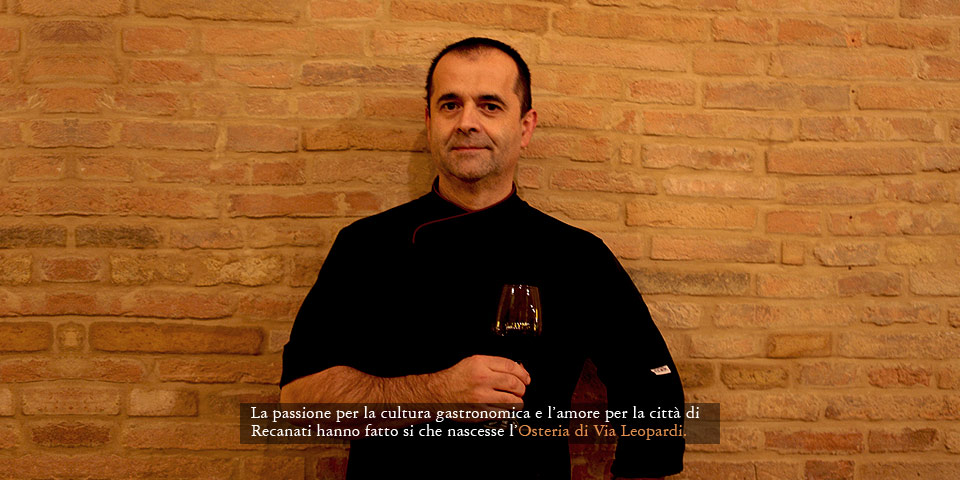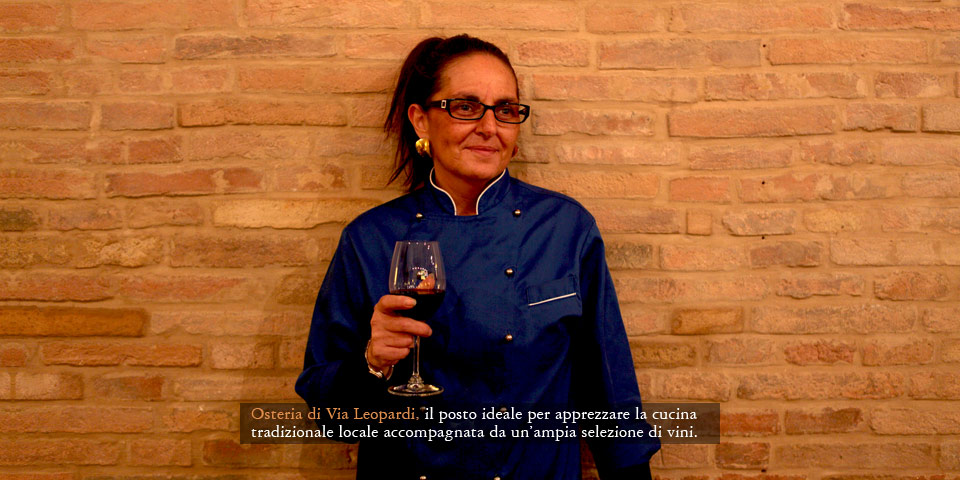
OUR HISTORY
Mauro Mengoni is the innkeeper: the son of a craftsman carpenter studied set design at the Academy of Fine Arts, and taking care of the preparation of a video bar in Recanati in 1985 he found himself involved in its management, thus transforming the pub into a pizzeria and then in a wine shop, with display and sale of typical products. The ever-growing passion for the gastronomic culture led him to attend many courses (becoming a sommelier), and then arriving at the conscious role of guide in the kitchen of his definitive creature, the Osteria Leopardi. In this management, his wife Lidia Sagni, the landlady, has been with her for years and has been a master of favors in the paternal shop, and has therefore brought this experience of her own into particular taste (enriched by attending cutting courses and working with the bread) of assortment of typical promotional baskets and trunks, assembled according to the spirit of the ancient festivals and traditional celebrations: this is the way in which the other important vocation of this place is favored, namely the enhancement and promotion of local artisan food production.

THE KITCHEN
The Osteria in Via Leopardi tells in the kitchen that Recanati territory (and in a broader sense Macerata and Marche) that it was not by chance called, also thanks to Giacomo’s poetry, “land of harmonies”. The recipes favor the local food resources in their natural cycle, with the care in the choice and the attention of the seasonality, in menus composed in such a way that the raw material emerges, an essential condition for the successful elaboration of a dish. The sense of territorial identity is also naturally present also in re-proposing ancient traditions of dishes that are lost in memories of countryside and villages, backwards from generation to generation. Whoever welcomes you to this tavern tries to give back certain sensations and rituals of cuisine and table lived in first person, through intersections and familiar encounters, such as the everyday life told by grandparents and aunts, or the memories of great country lunches, such as those for laborers and “machinists” during the beating of wheat. The echo of those sensations resonates in the dishes served here, enriched by other dishes and ritual customs of the Marche collected over time through knowledge, fortuitous encounters, elderly people near and far, and drawn from books and accumulated articles. The constant challenge is to know how to update and reinterpret the ancient rural and noble gastronomic culture of the Marche, from soups to vincisgrassi, adapting it to new sensitivities and dietary requirements, without for this distorting and debasing cooking modules which have by now been codified over time as historical, even in the they cross with ingredients initially alien to the local experience and then gradually become familiar. Usual “at home” dishes such as soups or vegetables (such as “skipped” soups) adapt to modern productions with ancient experiences, with archaic reverberations (such as candied cedar and pine nuts in certain almost Renaissance salads), and with the immediacy of unmistakable aromas of vegetable and spontaneous herbs, immediately evocative of these hills and their countryside, such as the thalli, that is the leaves of wild garlic. The standard tasting menu proposed here contemplates three appetizers, a first course, a second course, and dessert.
THE COFFEE’
At the entrance of the restaurant there is a cafe set up with essential furnishings, wanting to recall a little the gatherings, as well as the shelves that refer to the old grocery stores, where bottles and packages of wines and typical products are lined up, not just the Marche. The tourists who pass from here to Via Leopardi, headed for the home of the poet Giacomo, find a sort of embassy of the region, which goes beyond the conventional knowledge of ciauscolo and Verdicchio. Those who cross the threshold of the restaurant calmly savor a truce of marchigianità, those who stop with this special entrance via significant souvenirs of the spirit and the deep taste of these lands.
DINNER
From this attention to tradition and knowledge, the taste for proposing dinners based on the Leopardi theme is born. Through the table prepared, a story of the various phases of the poet’s life is proposed, through some significant foods and recipes documented in his life and through the very meaning of conviviality. Every dinner represents an ideal stage set for a narrative that will not only concern the parabola of its earthly existence, but also the life immediately eternal of its poetic heritage. And the table thus collects, through verses and life of the poets, once again, the pleasure of the body and soul, of the throat and of the freest and most inspired imagination.
